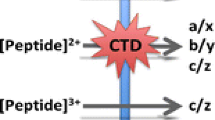Abstract
The mass spectral fragmentation of different 1-chloroalkanes (of the 1-chlorohexane-1-chlorooctadecane series) has been investigated, quantifying the relative abundance of the fragment ions. The base peak is dominantly at m/z 91, 93 in each investigated case, although with the increasing chain length, its contribution to the total ion current exhibits some reduction. Among the possible fragmentation products, the five-membered chloronium containing ring is the most stable as measured by an isodesmic reaction, although the six-and seven-membered rings exhibit only slightly reduced stability. The most stable structure of the 1-chlorohexane radical cation has a hydrogen bonded structure with the involvement of chlorine and the HC(δ), pre-forming the five-membered cationic ring. Accordingly, among the reactions leading to alkyl (or H) radical and a chloronium containing ring, this transition structure has the lowest energy, providing explanation for the experimental observations.






Similar content being viewed by others
Notes
The 1-fluoroalkanes provide low abundant C2H4F+ (m/z 47), C3H6F+ (m/z 61), and C4H8F+ (m/z 75) (Fig. S4); other CnH2nF+ ions are negligible [4]. This observation could be explained with the higher ionization potential and the resulting increased ion decompositions instead of CnH2nF+ formation. The ion decomposition is a HF elimination reaction that leads to various cyclic hydrocarbons fragments. The structures of cyclic products depend on the place of the eliminating hydrogen. It is noteworthy that 1-chloroalkanes molecular ions can also proceed through 1,3-eliminations of HCl to form ions containing a cyclopropane ring [5].
The C2H5O+ cyclic ions produced only from 2-bromoethanol, 2-nitroethanol, and direct protonation of ethylene oxide. However, other straight chain isomers of C2H5O+ also formed simultaneously from these compounds.
References
Göröcs N, Mudri D, Mátyási J, Balla J (2013) J Chromatogr Sci 51(2):138–145
McLafferty FW, Turecek F (1993) Interpretation of mass spectra, mass spectra of common compound classes, aliphatic halides, chapter 9, 4th edn. University Science Books, Sausalito, pp 279–281
Kimura K, Katsumata S, Achiba Y, Yamazaki T, Iwata S (1980) Handbook of HeI photoelectron spectra. Halsted Press, New York
McLafferty FW (1962) Anal Chem 34(1):2–15
Barbalas MP, Turecek F, McLafferty FW (1982) Org Mass Spectrom 17:595
Van de Graaf B, Dymerski PP, McLafferty FW (1975) J Chem Soc Chem Commun 978–979
Van deSande CC, McLafferty FW (1975) J Am Chem Soc 97:2298–2299
Beatty SD, Worley ISD, McManus SP (1978) J Am Chem Soc 100:4254–4260
See the web site at http://dasher.wustl.edu/tinker. Accessed 13 Nov 2012
Jorgensen WL, Maxwell DS, Tirado-Rives J (1996) J Am Chem Soc 118(45):11225–11236
Allinger NL, Yuh YH, Lii JH (1989) J Am Chem Soc 111:8551–8582
Frisch MJ, Trucks GW, Schlegel HB, Scuseria GE, Robb MA, Cheeseman JR, Scalmani G, Barone V, Mennucci B, Petersson GA, Nakatsuji H, Caricato M, Li X, Hratchian HP, Izmaylov AF, Bloino J, Zheng G, Sonnenberg JL, Hada M, Ehara M, Toyota K, Fukuda R, Hasegawa J, Ishida M, Nakajima T, Honda Y, Kitao O, Nakai H, Vreven T, Montgomery JA Jr, Peralta JE, Ogliaro F, Bearpark M, Heyd JJ, Brothers E, Kudin KN, Staroverov VN, Keith T, Kobayashi R, Normand J, Raghavachari K, Rendell A, Burant JC, Iyengar SS, Tomasi J, Cossi M, Rega N, Millam JM, Klene M, Knox JE, Cross JB, Bakken V, Adamo C, Jaramillo J, Gomperts R, Stratmann RE, Yazyev O, Austin AJ, Cammi R, Pomelli C, Ochterski JW, Martin RL, Morokuma K, Zakrzewski VG, Voth GA, Salvador P, Dannenberg JJ, Dapprich S, Daniels AD, Farkas O, Foresman JB, Ortiz JV, Cioslowski J, Fox DJ (2010) Gaussian 09 Rev. B.01. Gaussian Inc., Wallingford
Schaftenaar G, Nordik JH (2000) Molden: a pre- and post-processing program for molecular and electronic structures. J Comput Aided Mol Des 14:123–134
Keith TA (2011) TK Gristmill Software. AIMAll 11.10.16, Overland Park (http://aim.tkgristmill.com)
Bader RFW, Nguyen-Dang TT (1981) Quantum theory of atoms in molecules: Dalton revisited. Adv Quantum Chem 14:63–124
Hollóczki O, Terleczky P, Szieberth D, Mourgas G, Gudat D, Nyulászi L (2011) J Am Chem Soc 133:780–789
Wiberg KB (1968) Tetrahedron 24:1083–1096
Acknowledgments
Financial support from New Szechenyi Plan TAMOP-4.2.2/B-10/1-2010-0009 and OTKA K 170356 is gratefully acknowledged.
Author information
Authors and Affiliations
Corresponding author
Electronic supplementary material
Below is the link to the electronic supplementary material.
Rights and permissions
About this article
Cite this article
Benkő, Z., Göröcs, N., Könczöl, L. et al. CnH2nCl+ ion formation in electron impact MS conditions: a theoretical study. Struct Chem 25, 659–665 (2014). https://doi.org/10.1007/s11224-013-0371-5
Received:
Accepted:
Published:
Issue Date:
DOI: https://doi.org/10.1007/s11224-013-0371-5




